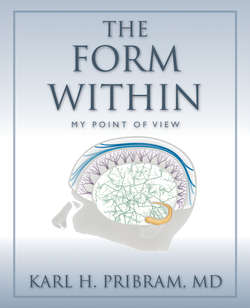Читать книгу The Form Within - Karl H Pribram - Страница 42
На сайте Литреса книга снята с продажи.
Feature Detection vs. Feature Extraction
ОглавлениеWithin the feature approach, two very different procedures can be followed. In one, the emphasis is on detecting some element in the sensory input, a bottom-up direction of inquiry; in the other, the feature is extracted from a myriad of sensory and cognitive processes in a top-down fashion. Extraction involves identification of the feature, essentially a creative process.
Different cells in the brain’s visual cortex differ in their response to the orientation, to the velocity or to the acceleration of movement of a line. We, as visual creatures, can analyze any scene into lines and edges; however, the maps of the brain’s receptive fields were initially interpreted not as analyzers of an entire vista but as brain cells that were “detecting” lines. A detector, as the word implies, needs to be uniquely sensitive to that which is being detected. A Geiger counter, fitted to detect radioactivity, would be useless if it were sensitive to everything in an environment including auditory noise, aromas, changes in visual brightness, or the contours of a shape.
The feature detection approach had an initial advantage in exploring form as Euclidian shapes. Maps of the receptive fields recorded from visual pathways yielded an “irresistible” progression: the maps change from a circular shape in the retina and the thalamus to an elongated shape at the cortex. An important aspect of the maps was that they were elicited only by stimuli of specific orientations (horizontal, vertical and all angles in between.) These oriented elongated shapes—interpreted as lines and edges—could then be considered to be a two-dimensional “stick-figure“ process representing features of our visual environment. But, as is well known, lines need not actually be present for us to perceive a shape.
16. The Kaniza Triangle
For example:
Contrary to what was becoming “established,” we showed in my laboratory that the supposed “Geiger counter” cells demonstrated sensitivities to many stimuli far beyond their sensitivity just to the presentation of lines. Some of these cells also responded to select bandwidths of auditory stimulation. All of them respond to changes in luminance (brightness), while other cells respond also to color. As described in Chapter 2, the Berkeley brain scientists Russell and Karen DeValois, on the basis of their decades-long experimental results, have constructed a model showing that the same network of cells can provide for our experience both of color and of form: When connected in one fashion, processing leads to the experience of form; when connected in another fashion, our experience is of color. The fact that a single network can accomplish both is important because we rarely experience color apart from form.
Perhaps more surprising was our finding that some of these cells in the primary visual sensory receiving cortex, when recorded in awake problem-solving monkeys, respond to whether the monkey’s response to a visual stimulus had been rewarded or not—and if so, whether the monkey had pressed one panel or the other in order to receive that reward.
